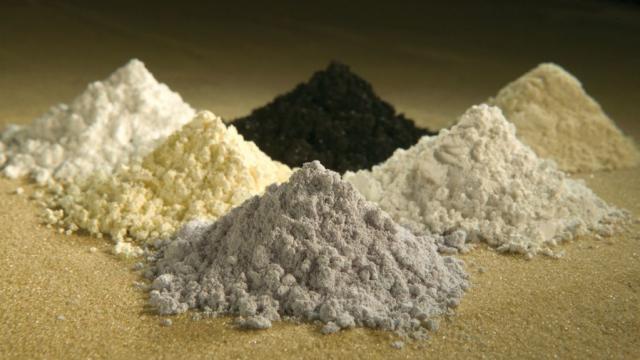You’ve probably heard a bit about rare Earth elements. They have got unpronounceable names like ytterbium and praseodymium, and they’re found in nearly ever piece of tech you own. Despite their value, we’re do a piss poor job recycling them. But chemists are now hoping to change that.
Clockwise from top center: Rare Earth metals praseodymium, cerium, lanthanum, neodymium, samarium, and gadolinium.
As we continue to mine our ever-dwindling supply of rare Earths, researchers at the University of Pennsylvania are trying to figure out how we can reduce our dependency on environmentally destructive extraction processes. And they seem to be making progress. A new study published in the journal Angewandte Chemie, International Edition describes a process that could enable us to efficiently recycle neodymium and dysprosium, two elements that comprise the magnets found in everything from electric motors and generators to headphones and hard drives.
Mining and refining rare Earths is dirty business. To accumulate an appreciable amount of these elements — so named for their low concentrations in the Earth’s crust — we have to dissolve large chunks of natural minerals, a process that involves an elixir of nasty industrial acids and other solvents. In doing so, we also extract radioactive elements such as thorium and end up generating tremendous amounts of toxic waste. It’s not hard to see why we’d like a better way of recovering these metals, but so far, our record isn’t impressive.
The chemists’ new method is a step in the right direction. Neodymium and dysprosium are often mixed together to create magnets with excellent magnetic and thermal properties. But because different ratios of the two elements are needed for different applications, it would be great if we could tease them apart again after use. Starting with a powdered mixture, the researchers showed that the two metals can be separated almost instantaneously using a specialised ligand that binds neodymium. Once separated, weak acids can strip the ligand away, allowing both metals to be recycled.
“If you have the right ligand, you can do this separation in five minutes, whereas the liquid-liquid extraction method [used in mining] takes weeks,” lead study author Eric Schelter said in a statement. “A potential magnet recycler probably doesn’t have the capital to invest in an entire liquid-liquid separations plant, so having a chemical technology that can instantaneously separate these elements enables smaller scale recyclers to get value out of their materials.”
The researchers hope that their new method can be modified for other applications, such as extracting rare Earths from compact fluorescent bulbs. Let’s keep our fingers crossed for more progress on this front, because a worldwide rare Earth metal shortage isn’t going to be pretty.
Top image via Wikimedia
